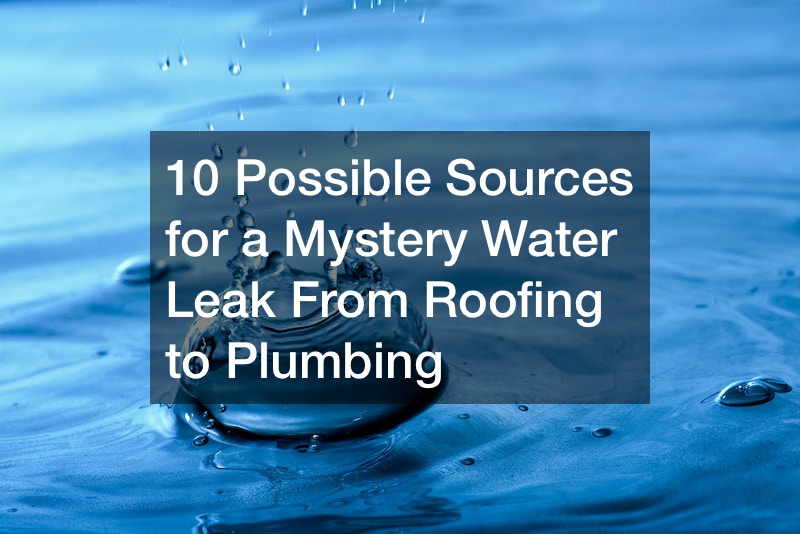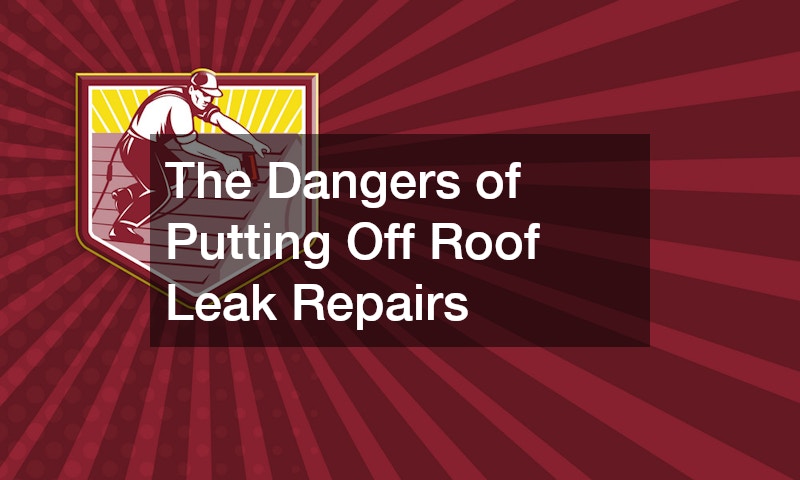When you spot a mystery water leak in your home, address it immediately. Determining the source of the leak lets you repair it before it causes serious damage to your home. You may need one or more professional contractors to make appropriate repairs. Finding the leak’s source lets you apply damage control methods until the contractors arrive and make repairs.
What signals a water leak?
What signals indicate your home has a water leak? Water stains on the ceiling or wallboard indicate water presence. A puddle on the floor does, too. If you reside with others, check with them to learn if someone spilled water or a clear soft drink. A dripping sound indicates a leak somewhere, too.
Leaks occur in a variety of places throughout the home. Causes vary. Let’s consider the ten most common leak sources and who to call to get it repaired as soon as possible.
1. Minor Storm Damage
Your mystery water leak could come from storm damage or from a window left open while it rained. Mop up the water and lift any floor covering to survey the subfloor beneath. Also, scan the ceiling for potential signs of a leak; go outside and look at the roof where the puddle occurred.
A floor leak could lead to a siding issue or mean that water accumulated beneath the home and seeped upward, something that happens occasionally with homes that feature crawlspaces or low-height piers and pilings foundations. A ceiling leak indicates roofing damage. For a floor-level source, phone a general contractor, but for a roofing issue, hire a roofer to repair the damage using materials with all weather durability.
An open window makes it easier to deal with the problem. Shut the window and create a house rule that an hour before a forecasted storm, you shut all windows in the home. This prevents future damage.

2. Old Windows
Sometimes, you did shut the windows, and your mystery water leak comes from the age of the windows. As windows age, they lose function due to cracked panes and broken seals. If a home features wood window frames the wood could rot or crack. These damage types can allow water to enter.
Contact a window installer to remove your current windows and replace them with new ones. Consider purchasing Low-E (low emissions, low energy) windows with double or triple-pane glass. These highly efficient windows can help reduce your energy bills, too.
3. Faulty Fire Sprinklers
As awful as it may seem, your home’s mystery water leak could come from its fire suppression systems. Sprinklers can leak. Did a puddle form beneath your interior sprinkler? Check the attic installation of this home safety feature to determine if it caused the problem.
If the sprinklers reveal the leak problem phone a plumber. The repairs may consist of replacing pipes or the sprinkler itself. The plumber’s consultation typically includes a repair estimate.
4. A Leaky Garage Door
Sometimes, you find a mystery water leak in the garage. After checking the ceiling and roof, it turns out that the garage door caused the problem. Either storm damage or improper installation caused the issue.
Contact a professional garage door installer to determine which caused the issue. If the original door simply got improperly installed, the repair team can rehang it unless it incurred damage. A damaged door, especially one with bent framing or heavy denting, means replacing your garage door will fix the problem.
Garage doors cost between $800 and $4,000, depending on how fancy a door you choose. Don’t let your installer pressure you into spending more money than you need to spend. Many of the top garage door firms manufacture budget options that cost less than $1,000 and do a great job at keeping your home and auto safe.

5. A Faulty Water Heater
Since their inception, water heaters have proved to be the source of many a mystery water leak. Hot water for hand washing, bathing, and washing dishes proves awesome, but a leak doesn’t. Mop the area of the leak and dry off the water heater. Have a second person turn on the hot tap of a sink or the bathtub while you observe the water heater.
Warning: watching a water heater for a leak proves tantamount to watching grass grow, but finding the source of the problem saves you labor costs. Similar to the HVAC team, plumbers charge by the hour, and diagnostic tests eat up a lot of hours. It may take some time for the leak to reveal itself because some leaks only evidence themselves during a heavy water load, such as a bath or doing laundry. Call a plumber for repairs when you determine what leaks on the water heater.
6. Malfunctioning Plumbing Fixtures
Although you might think to call a plumber when you spot a mystery water leak in your bathroom or water closet, call a bathroom contractor instead. In an enclosed space like the bathroom, you can easily spot the leak by mopping the floor and drying it. Next, use each water source in the room, one at a time. Start with the toilet and sit on the stool when you test it.
Here’s a little-known secret that can save you a lot of money. When the seals around the bottom edge of a toilet wear away or break, the toilet leaks. The problem may be the caulking, which you can repair in an afternoon for less than $20. If the toilet rocks or wiggles when you sit on the stool, you need to hire a bathroom contractor because the bad caulk leak has rotted the subfloor beneath the toilet.
Leaks from the sink faucet typically stain the basin. That indicates a need for a washer replacement, which you can do for less than $2. A leak beneath the sink from the pipes requires a plumber, while the damage to drywall and potentially the subfloor requires a general contractor. A bathroom contractor holds licenses for both work types.

7. Swamp Cooler Problems
Your mystery water leak might stem from a swamp cooler or air conditioner issue. Swamp coolers use the generation of high humidity by blowing air across a cold, wet surface. If you don’t clean them frequently, they can develop mildew or mold. The units may leak water out of their reservoir or overfill the sponge used at the bottom of the water tray.
Try the simplest solution first. Place a thick, absorbent towel beneath the swamp cooler. If this catches the water and stops the leak, you’re done.
If that doesn’t work, turn off the cooling unit. Dry it completely, wiping off the exterior completely, so you can see where the leak comes from when you turn it back on. Dry the sponge at the bottom of the cooling dish and empty the water reservoir.
Refill the reservoir, watching for any leaks. Plug the device into the outlet and turn it on. Observe its operation to determine the leak’s origin. This may take a while, so if the leak’s origin doesn’t immediately evidence itself, begin checking the cooler every 10 minutes for leaks.
When you observe the leak, contact an air conditioning repair service. Why? HVAC charges by the hour, so if you can determine the source of the leak and inform them of it, you save yourself the cost of them performing the diagnostic tests to locate the leak source. The repair team only needs to fix the leak, so it no longer happens.
8. Damaged Metal Roofing
Some mystery water leak issues stem from a damaged roof. Although metal roofs typically last up to 50 years, that figure refers to modern metal roofs, not tin roofs, which the professional roofing industry eliminated post-World War II. Check the interior ceiling for water spots and the exterior of the home at roof height for damage to metal panels or flashing.
Roof repair requires a roofing professional to repair. Forget about trying to patch it yourself; hire roofing contractors to replace the leaking metal panels. If your home features an older style of metal roof and incurred bad damage, the roofer will probably suggest a roof replacement. Try a standing seam metal roof, a design that holds up well in every area of the U.S.
9. Shingle Roof Woes
Asphalt shingle roofs, like metal roofs, can develop leaks. Your home’s mystery water leak might come from above – your roof. Note when you notice the leak. Does it occur every time it rains or snows? If the windows remain shut and the leak only appears when it rains, your roof probably leaks.
Figure out the source or leak area and place a bucket beneath it. Phone local roofing services for emergency service. Many roofers offer 24/7 emergency services. If the roof didn’t reveal a leak issue, check your heating system.

10. Radiant Heat System Leaks
Look at your heater. It may be the culprit causing your mystery water leak. If you noticed the water puddle or drywall damage around the time of fall, when you first used the heater, this enhances the chances it causes the problem. Turn on the heat and observe the radiant heat system near the leak area to pinpoint the source.
Once you spot the source, turn off the heater, and phone a professional who specializes in heating repairs. In cold weather, use a space heater or a fire in the fireplace until the repair pros can rectify the problem. This method keeps you warm while stopping further water damage.
Running a system check in early fall each year and performing manufacturer-recommended maintenance on your heating system can result in better performance. Maintenance lets you spot problems when they start and fix them before they can cause damage. Keep a backup method of heating handy, in case problems with your main heater arise.
Finding the Right Contractor
Finding the right contractor for a leak repair job can seem challenging. Many leaks involve plumbing issues, but some don’t. That means that you won’t always need a plumber.
Determine the source of the leak to determine who to turn to for repairs. In general, if it comes from:
- Pipes, call a plumber
- HVAC or a water heater, call an HVAC repair service
- Roof leaks, call a roofer
- Flooring, call a general contractor.
In some cases, you’ll need a general contractor or bathroom or kitchen contractor to repair all of the issues.
Stopping More Damage from Occurring
As soon as you notice a leak and determine its origin, stop using the utility causing it, if applicable. In cases of roof leaks, patch the interior entry point with temporary materials and place a bucket or pail beneath it to catch drips until the professional arrives to repair it.
A leak allows more than water to enter. It also lets in hot air during summer and cold air during winter, both of which drive up your energy bills. Leaks do much more than cause water damage.
When caught quickly, leaks may not do any discernable damage. When they go unnoticed for any length of time, they can do serious damage. This damage might include wood rot, tile damage, ruined carpets, or loosened adhesive on flooring.
That means that repairing the problem requires more than fixing the source of the leak. Complete repair requires addressing the damaged areas that incurred water seepage, staining, or rot. In some situations, it requires replacing subflooring with new plywood and/or framing boards. This process restores the structural stability and the appearance of the home.
Getting Started with Leak Repairs
A home’s water leaks don’t have to cause major damage. Caught early, a leak may cause no damage, especially when immediately repaired by the appropriate construction professional. Conduct a monthly walkthrough of your home’s interior and exterior to catch problems before they grow. Have them repaired as soon as possible.




